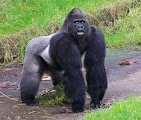Mountain
gorillas are among few primates whose population slowly keeps increasing in the
wild. Rwanda’s gorillas have drastically increased and the option that the government
is left with is to extend their natural habitat so as to accommodate all of
them. Gorilla trekking safaris in Rwanda takes place in Volcanoes National
Park, Northwestern side of the country where these impressive apes thrive. On 1st
September, a sum of 19 newborn baby gorillas will be given names at Kwita Izina
ceremony which will add the number to about 400 unique primates that already live
in the park. Several of these youngsters were born in the previous year, but
some are already adults that joined the followed families during that time,
arriving from families which have not been followed some times from over the
border in Democratic Republic of Congo.
 |
| GORILLA NAMING IN KWITA IZINA |
The following are some of the gorillas
that Dian Fossey Fund International follows and officially are to be given
names on 1st September 2017.
Mitimbili’s infant; a male
born on 24th April 2017. This is Mitimbili’s 4th infant
and amazingly all are males and stay in the same big gorilla family.
Kurudi’s infant; a
female born on 4th August 2016. It is Kurudi’s 4th
offspring but she has stayed in most of gorilla families and her infants are
scattered out. Her recent family consists of 2 silverbacks that offer
protection.
Tamu’s infant; gender
still not known but born on 8th September 2016. Tamu and her
offspring stay in a tiny family with only 3 females, 2 offspring and the
dominant silverback gorilla-the youngest leader that is monitored.
Ukuri’s infant; gender
also still not known born on 7th August 2016. It is Ukuri’s 4th
offspring and enjoys playing with 3 other offspring in his increasing family,
headed by magnificent dominant silverback Mafunzo.
Mahirwe’s infant; a
female born gorilla of around 1st April 2016. The date of birth isn’t
known because the family was ranging in the Congo part of the mountains when
she was born. The family doesn’t have any other offspring at a moment but the
new offspring has a juvenile sister to play with.
Tegereza’s offspring; a male
first sighted on 7th March 2017. Tegereza’s offspring was born while
the family was ranging in Congo and is her 2nd offspring. He has a
juvenile brother in the family.
Adult
female gorilla in Ntambara’s family;
this was first sighted on 8th 2017. It was sighted in the family
when they came back from ranging in Congo. Based on her size and appearance,
she was estimated to be around 9 years.
The
Rwanda Development Board tourism chamber said, since 2005, a sum of 280
mountain gorillas have been born and awarded names. Eugene Mutangana; the head
of conservation at Rwanda Development Board (RDB) added that the increasing
number of mountain gorillas is a step forward. The increase in gorilla number
means gorilla trekking safaris in Volcanoes National Park will also be boosted.
Mutangana said, “We are currently thinking of either buying or hiring land from
residents to extend the gorilla habitat.” The process may take about 4 to 6
years!
It is
anticipated that the number of these endangered species will come up to 540 by
the next population census that is anticipated to end this year. Mountain
gorilla safaris contribute about 90% of government revenues from national
parks. Only in 2016, Rwanda generated $404 million from tourism. The target is
to reach $444 million in 2017.
Ever
since the end of the horrific genocide that took place in 1994 between the
Tutsis and Hutus, mountain gorillas have got harmony in Rwanda and gorilla
trekking safaris in Volcanoes National Park have also been boosted. Tourism
specialists assert that for tourism to thrive, peace and stability should be in
place which is the basic need for wildlife species like great apes in the wild
as well as gorilla trekking trips.
At the
opening of the 3rd day 41st Annual tourism conference in
Kigali, Dr. Mukhisa Kituvi (secretary general of the United Nations Conference
on Trade and Development (UNCTAD) added that violence across the African continent
has been the primary challenge to tourism development. But with Rwanda’s
current peace and stability, mountain gorillas have found it simpler to survive
in harmonious Rwanda than its neighbor Democratic Republic of Congo (DRC).
Mountain
gorillas are critically endangered apes which thrive in the Virunga Mountains
and in Bwindi Impenetrable Forest in the misty valleys of Southwestern Uganda.
Virunga Volcanoes features a chain of volcanic mountains which extend from Mgahinga
Gorilla National Park in Southwestern Uganda, Volcanoes National Park in Northwestern
Rwanda and the Virunga National Park in DRC. However, the management Gishwati
Mukura landscape another addition to Rwanda’s national parks, has been placed
under RDB rehabilitation of the natural habitat in and outside the park that
began in 2016 at a cost of $9.5 million in 5 years.
Therefore,
with the new expansion to the tourist destination, the rare mountain gorillas
can find more protection and safety in Rwanda. This will support their general
behavior including breeding and at the end, their population increases and thus
gorilla trekking safaris in Rwanda will also increase.





